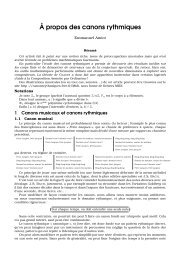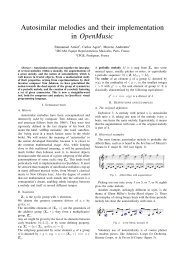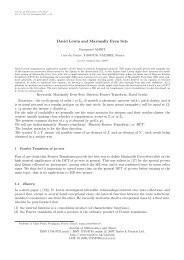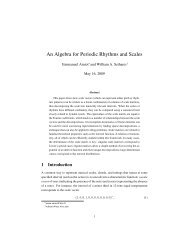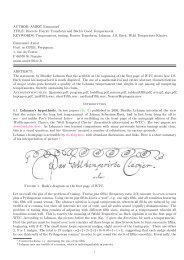Emmanuel Amiot Modèles algébriques et algorithmes pour la ...
Emmanuel Amiot Modèles algébriques et algorithmes pour la ...
Emmanuel Amiot Modèles algébriques et algorithmes pour la ...
Create successful ePaper yourself
Turn your PDF publications into a flip-book with our unique Google optimized e-Paper software.
ass:<br />
GGGE♭ 13<br />
x ↦→ x, x + 4, 3x + 1, 3x + 5, 5x, 5x + 4, 7x + 1, 7x + 5<br />
Complicated symm<strong>et</strong>ry groups are possible (the <strong>la</strong>st one, often called H8, is not abelian). As all powers<br />
of f are in the symm<strong>et</strong>ry group, we can at least predict from Lagrange’s theorem that<br />
Lemma 3.3 The order of the group of symm<strong>et</strong>ries of M is a multiple of o(f).<br />
It is interesting for composers, and maybe analysts alike, to find a melody with a given symm<strong>et</strong>ry group.<br />
For instance one may wish to find an 8-periodic melody, palindromic, and autosimi<strong>la</strong>r with ratio 3. Hence<br />
the orbit of 1 must contain −1 = 7 (for palindromicity); as it contains 3, 5 = −3 is there too. Hence O1<br />
contains all odd numbers.<br />
Acting simi<strong>la</strong>rly with the remaining residue c<strong>la</strong>sses, one finds the primitive solution O1 = (1, 3, 5, 7), O2 =<br />
(2, 6) with 4 and 8 standing alone as fixed points. A rendering of this unique solution is the Alberti Bass.<br />
This leads to the most general definition so far, which indeed should be the starting point for the study of<br />
melodies invariant under some affine maps:<br />
Definition 3.4 An autosimi<strong>la</strong>r melody M with period n and symm<strong>et</strong>ry group G ⊂ Affn is any map<br />
M : Zn → (some pitch s<strong>et</strong>) that satisfies<br />
∀f ∈ G ∀k M f(k) = Mk<br />
Theorem 3.5 Such a melody is built from the orbits of G, i.e. each pitch appears on indexes that are a<br />
union of orbits Ox = {f(x), f ∈ G}.<br />
Algorithmically speaking, one usually wishes to consider only some symm<strong>et</strong>ries in G. An orbit will be<br />
produced by repeatedly applying the given affine maps, starting with a given seed, until no new number<br />
is produced. 1 This <strong>la</strong>st definition reduces to the previous one when the group of symm<strong>et</strong>ries is cyclic,<br />
generated by just one map.<br />
It must be pointed out that the group of symm<strong>et</strong>ries eventually achieved is usually <strong>la</strong>rger than the group<br />
one starts from; not any odd group is the symm<strong>et</strong>ry group of some object: for instance modulo 8, this<br />
Klein group<br />
K = {x ↦→ x, x ↦→ 3x + 1, x ↦→ x + 4, x ↦→ 3x + 5}<br />
is not the symm<strong>et</strong>ry group of a melody: its orbits are (0, 1, 4, 5), (2, 3, 6, 7), and the symm<strong>et</strong>ry group of any<br />
melody built up from these [say CCGGCCGG. . . ] is strictly <strong>la</strong>rger (for instance it contains x ↦→ 5x + 4),<br />
with 8 elements.<br />
Remark 2 Musically speaking, for such an autosimi<strong>la</strong>r melody with a non cyclic group of affine symm<strong>et</strong>ries,<br />
it is possible to extract the melody from itself at different ratios. A simi<strong>la</strong>r situation will arise in the <strong>la</strong>st<br />
section.<br />
3.2 Palindroms<br />
Now we can c<strong>la</strong>rify when a given autosimi<strong>la</strong>r melody will be a palindrome, as this means exactly that<br />
x ↦→ −x is an element of the group G of symm<strong>et</strong>ries. The answer is obvious when G is generated by<br />
ha : x ↦→ a x, as we have seen that the symm<strong>et</strong>ries must be powers of ha:<br />
1 The underlying idea is that: any orbit is a fixed point of the action of any s<strong>et</strong> of generators of G on the s<strong>et</strong> of all subs<strong>et</strong>s of Zn. This<br />
was implemented in OpenMusic, cf. [3].




